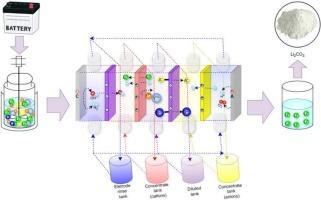锂离子电池湿法冶金工艺中电渗析分离锂的研究进展
IF 5
2区 工程技术
Q1 ENGINEERING, CHEMICAL
引用次数: 0
摘要
从废旧锂离子电池(lib)中回收有价值的金属对于缓解关键金属的提取和稀缺问题至关重要。通过电渗析(ED)从锂浸出液中分离纯化锂被认为是一种很有前途的分离单价阳离子和二价阳离子和阴离子的方法,但由于这些方法的复杂性和工艺参数满足经济和技术要求,仍然具有挑战性。本文综述了锂离子电池回收利用技术的研究进展。处理高浓度浸出液时,ED耗电量大;另一方面,与溶剂萃取或沉淀等常用技术相比,减少了化学品的消耗量。一价iem对Li离子具有高度选择性,而络合剂(如EDTA或DTPA)可以在ph依赖性反应中将二价阳离子转化为阴离子,而阴离子被阳离子离子交换膜高度排斥。尽管如此,膜污染和长期降解等挑战仍然存在。本文旨在为今后的发展提供指导,提高锂离子电池的回收效率。本文章由计算机程序翻译,如有差异,请以英文原文为准。

Li separation by electrodialysis in hydrometallurgical processing of Li-ion batteries: a review of the state-of-art
The recovery of valuable metals from spent Li-ion batteries (LIBs) has become crucial to mitigate issues related to critical metals extraction and scarcity. The process of separating and purifying Li from LiBs leach solution through electrodialysis (ED) is considered a promising approach for separating monovalent cations from divalent cations and anions but remains challenging due to the complexity of these solutions and process parameters meeting economic and technical requirements. This review highlights advances in ED technology for LIBs recycling. ED is high electricity-consuming when processing high concentration leaching solutions; on the other hand, reduces the amount of chemical consumption in comparison to common techniques such as solvent extraction or precipitation. Monovalent-IEM has demonstrated highly selective for Li ions, while complexing agents (e.g. EDTA or DTPA) can transform in a pH-dependent reaction divalent cation into anions that are highly rejected by cationic ion exchange membranes. Nonetheless, challenges such as membrane fouling and long-term degradation persist. This review aims to provide guidance for future advancements and improve the efficiency of LiBs recycling.
求助全文
通过发布文献求助,成功后即可免费获取论文全文。
去求助
来源期刊

Minerals Engineering
工程技术-工程:化工
CiteScore
8.70
自引率
18.80%
发文量
519
审稿时长
81 days
期刊介绍:
The purpose of the journal is to provide for the rapid publication of topical papers featuring the latest developments in the allied fields of mineral processing and extractive metallurgy. Its wide ranging coverage of research and practical (operating) topics includes physical separation methods, such as comminution, flotation concentration and dewatering, chemical methods such as bio-, hydro-, and electro-metallurgy, analytical techniques, process control, simulation and instrumentation, and mineralogical aspects of processing. Environmental issues, particularly those pertaining to sustainable development, will also be strongly covered.
 求助内容:
求助内容: 应助结果提醒方式:
应助结果提醒方式:


